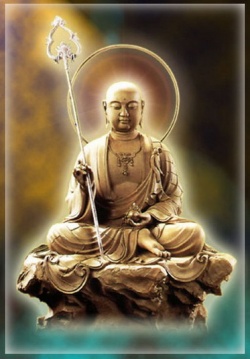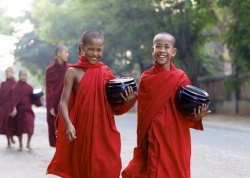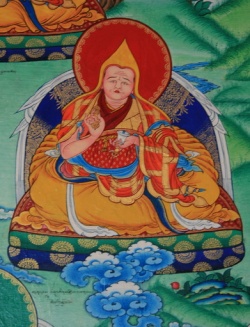Buddhism Observances
Buddhism in practice is more than just learning about the life of the Buddha and His Teaching. It includes many observances, some of which are common to all Buddhists while others are characteristic of a particular culture or country. In Buddhist homes and temples, one will see examples of such observances. They may take the form of offerings and bowing before the image of the Buddha or the chanting of certain verses or lines from Buddhist scriptures. On special days, like Vesak and Ulambana, one will see the Buddhist community commemorating the occasion through various religion activities. Through these observances performed individually or a communal acts, the Buddhist venerate and show their appreciation of the Triple Gem (Buddha, Dharma & Sangha).
Buddhist Shrines and Images
Man has always felt the need to remember the things he loves and reveres in a form that he can feel and see before him. A person may keep a photograph in order to recall a loved one who has gone abroad or has passed away. One may also feel a great sense of pride and love for a country when standing at attention before the national flag. The photograph and national flag are examples of symbols that enable one to remember the qualities of the people or things that are being represented. They form the focal point of one’s feeling of love, respect or patriotism.
Similarly, the shrine found in Buddhist homes or temples is a focal point of Buddhist observance. At the centre of the shrine, there is usually an image of the Buddha. The image may be made of variety of materials such as marble, gold, wood or even clay. The image is a symbol that helps people to recall the qualities of the Buddha.
The Shrine may also have such objects as a volume of Buddhist scriptures to represent the Dharma. Some shrines may include other items such as images, pictures or photograph of Buddhist monks and master to represent the Sangha. When a Buddhist stands before a shrine , the objects he sees on it help him to recall the qualities that are found in the Buddha, Dharma and Sangha. This inspires him to work towards cultivating these qualities in himself.
Gesture of Reverence
People in all culture have certain gestures, or actions, which express their love and respect for others, such as bowing, taking off the hat, folding hands and kneeling. In Buddhism, the traditional gesture of reverence to the Triple Gem is to place the palms of both hands together and raise them high in front, usually up to the level of the forehead. In order to express deep veneration, a Buddhist may bow or prostrate before the image of the Buddha, members of the Sangha and the master of the Teaching. When a Buddhist prostrates before an image, he acknowledges the fact that the Buddha has attained the perfect and supreme Enlightenment. Such an act helps the Buddhist to overcome egoistic feelings and he become more ready to listen to the Teaching of the Buddha.
Cirumanbulation is the act of going round an object of veneration for three or more times. The act is practised not only by Buddhist but also by members of some other religions. Buddhist cirumambulate shrines, temples and other religious objects such as stupas or the Bodhi tree. They walk in slow, measured steps in a clockwise direction, keeping their right side towards the object of veneration. This is one way Buddhist focus their attention on the object and is gesture of respect.
Making Offerings
It is a common custom for people to offer gifts and tokens to other as an expression of their love, appreciation or veneration. Similarly, the making of offerings at the shrine in the home or temple is a way of expressing one’s appreciation and veneration for the Triple Gem. A Buddhist offer to the Triple Gem only those things the he consider to be pleasant, pure or valuable. Some of the usual offerings at the shrine include light in form of lighted candles, oil lamp or even electric lights. Additional offerings may consists of flowers, incense, fruit, water and food.
Light symbolises wisdom as contrasted to darkness which symbolises ignorance. Thus the offering of light to the Triple Gem reminds a Buddhist that the goal of Enlightenment is attained when wisdom drives away the darkness of ignorance.
The flowers which are offered at the shrine are fresh, fragrant and beautiful at the time when they are placed before an image but will soon become withered, scentless and discoloured. The offering of flowers reminds the Buddhist of the impermanence of things, an important teaching of the Buddha.
When incense is lit, it fragrance fills the air. This is like the spreading of the purifying effect of wholesome conduct. So offering incense, a Buddhist not only express his veneration for the Triple Gem but also reminds himself of the practice of Good Conduct.
The Buddhist who makes offerings to the Triple Gem gains merits. This is especially so when he is mindful of the significance what is being offered.
We do not make offering because the Buddha needs our offerings. When someone has purified all defilements and enjoyed the bliss that come from wisdom, he/she certainly does not need an incense stick to be happy! Neither do we made offering to win Buddha favour. The Buddha developed impartial love and compassion long ago and will not be swayed by flattery and bribery like ordinary beings! Making offering is a way to create positive potential and to develop our mind.
Chanting and Recitation
Just as prostration, cirumambulation and offering are the physical expressions of one veneration for the Triple Gem, Buddhist chanting and recitation express the same through words. This is similar to singing the national anthem and reciting the pledge of allegiance before the national flag as an expression of loyalty and respect for one’s nation.
Buddhist chanting and recitation take three major forms. Firstly, words or verses may be recited in praise of the Buddha, Dharma and Sangha. Secondly, the Buddhist may also recite the sermons of the Buddha. Thirdly, he may chant short phrases or syllables that symbolise certain teachings or qualities of the Buddha. These symbolic phrases or syllables are called Mantras. When a Buddhist chants a mantra, it help to recall either the essence of a particular teaching or a special quality of the Buddha, such as His great compassion.
Therefore, chanting and recitation are not just acts of homage to the Triple Gem. They also remind the Buddhist of the ideal qualities of the Triple Gem that he strives to achieve. Furthermore, chanting and recitation also help him to concentrate and develop a clam and peaceful state of mind.
Popular Observances of the Buddhist Community
1. The Observance of Vesak
The most important event in the year for the Buddhist community is the observance of Vesak which commemorates the birth, Enlightenment and Final Nirvana of the Buddha. Vesak falls on the full moon day of the fifth month of the year. This occasion is observed by millions of Buddhists throughout the world.
For some Buddhists, the observance of Vesak begins early in the morning when they assemble at the temple to observe the Eight Precepts. Others may join the communal observance later by going through the ceremony of taking the Threefold Refuge, observing the Five Precepts, making offerings at the shrine and by chanting and recitation. They may also participate in processions and circumambulation , and listen to discourses on the Dharma.
In some temples, Buddhists take part in the ceremonial bathing of the statue of baby Prince Siddharatha. A small standing statue of the prince is placed in a basin of perfumed water strewn with flowers. The Buddhists scoop the perfumed water with a ladle and pour it over the statue. This act of bathing symbolises the purification of one’s unwholesome actions.
On Vesak Day, some Buddhists release captive animals such as birds and turtles. This act of kindness recalls the Buddha’s teaching of universal compassion. Many Buddhist also take vegetarian meals on this day. The temples are often colourfully decorated with Buddhist flags and lights. The shrines are also filled with flowers, fruit and other offerings brought by Buddhists. Vegetarian meals are often provided for all those present on this occasion.
2. The Observance of New Moon & Full Moon Days (Upavasatha Days)
On the first and fifteenth day of the lunar month, which are the new moon and full moon day respectively, many Buddhists assemble in the temple to meditate, make offerings, recite sermons and perform acts of veneration for the Triple Gem. Many also take vegetarian meals on these days and some may also choose to observe the Eight Precepts.
3. The Observance of Ullambana
The observance of Ullambana is based on the story of Maudgalyayana and his mother. According to popular Chinese tradition, Maudgalyayana discovered through his meditative powers that his mother had been reborn in one of the realms of misery. Distressed over the tormented state of his mother, he approached the Buddha for help. The Buddha then advised Maudgalyayana to make offerings to the Order. The merit of making this offering would help to relieve the suffering not only of his mother, but also that of other beings in the realms of misery. It is said that as a result of Maudgalyayana’s offering, his mother was soon released from her unhappy state.
As a result of this incident, the act of making offerings to relieve the suffering of departed parents as well as other beings in the realms of misery, became a popular communal observances in China. This is called the observance of Ullambana, which takes place on the fifteenth day of the seventh lunar month. To this day, in various parts of the world, Ullambana is still being observed.




